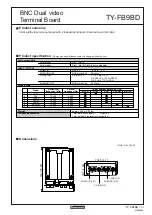
7
Connection of the Wall Panel Plug
The Unit is equipped with a 15 Pin High Density DIL Plug.
•
Turn counter-clockwise the two retaining clips at the top of the Panel, and open.
•
Insert Wall Panel Plug into the Socket. Tighten retaining screws.
•
Turn Power ON.
•
Close the panel and lock.
CAUTION! Do not install the panel until all wall finishes are complete. Verify that the plugs are configured
correctly. Incorrect insertion will prevent operation of unit.
Verify that the Sensor is designed for the Appropriate Fuel Gas:
The Model Number of the Sensor is located on the carton and inside the wall box. FGS-3X13 is intended for use
with natural gas. FGS-3X23 is intended for use with LP or Propane gas. If the Model number of this unit does not
match the application, stop and contact your ISIMET representative.
Operation of the Unit:
The Panel LED is bi-color (Red – Green). During the warm-up period the LED will flash green. The LED will
remain a constant green during normal operation. This LED color will change from green to red should the sensor
fail. The sensitivity of the unit is settable 500 ppm to 100,000 ppm. Factory Setting is 500 ppm and may be
adjusted downward (requiring more ppm to detect) by turning the integral variable resistor to the left (CCW).
Time delay feature is factory pre-set based on customer ordering stipulations. Settings other than 0 will allow a
brief period between detection and notification so that the gas outlet that is the cause of the detection can be turned
OFF before the unit transmits a shut-down signal. During this period the panel mounted lamp will flash notifying
the user that raw fuel gas has been detected. Once the time delay elapses the signal is transmitted and the lamp
remains constant. Once the notification is transmitted the unit will turn ON the Output Notification Circuits. For
Time Delay Settings at JP5, the Jumpers should be positioned left to right on the pins. See the instructions provided
for the monitoring device for connection to those devices.
Test the Unit: (Recommend that two persons perform this test)
Turn on the Fuel Gas Sensor. Connect a small rubber hose of sufficient length to a nearby fuel gas outlet. Extend
the open end of the hose to the Fuel Gas Sensor. Slightly open the gas outlet, pointing the open end closely towards
the louver. The lamp should remain ON constant. The fuel gas circuit as well as other circuits determined to be
effected by the sensor should turn OFF. The flow of gas should stop.
NOTICE:
If this test does not result in the receipt of a notification signal, turn OFF the Gas Sensor and perform tests to
determine the cause of this failure. If a cause cannot be determined and then rectified, contact an ISIMET or your
local Service Representative.


























